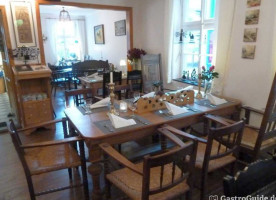Imagini
ContribuieRezervă acum
Recenzii
Contribuiți la feedbackIf you meet local heroes of the gastro scene on site, you often go home with some valuable tips. It's good that after the wonderful evening with Borgi and accompaniment to the corner Italian, we still had plenty of time to tackle his culinary suggestions. The next morning – the Italo-Preziosen from the eve were halfway digested – there was a desire for a good breakfast in our cosy ambience. Following Borgfelder's tea tip, we moved to the old town of Bremer, more precisely to the historical Schnoor district. There, in the middle of narrow alleys, there is a narrow, tastefully restored half-timbered house, in which on three floors it can be excellent tea drink and wait (or vice versa). The visit to the oldest district of the Hanseatic city is like a time trip to the 15th. Century before. It's no wonder that the tourists (like me) are walking around here. I am not surprised by the Danish, English and Japanese phrases from the side tables. The place where the teastub is located is still called the “Wüstestätte”. This name goes back to 1659. At that time, the houses fell victim to a devastating fire. After long moorings the buildings were in the 18th And 19th century rebuilt and only the name reveals something about the dark past. The richly signposted entrance area is made up of “more than 100 varieties of tea in the sink”, a healthy seasonal cuisine and the possibility of taking breakfast from 10 am to 6 pm. The teahouse is a cafe, restaurant, wine and tea room in one. Wouldn't be laughed if we didn't find the right thing to strengthen here. On the ground floor, the new enthusiast expects nostalgic museum interior and a lot of Hanseatic lifestyle. Only the antiquarically graceful checkout on the sales street before the decorative wooden tea rack is a real eye-catcher. We were welcomed by a friendly service lady and guided two floors upwards over narrow steps. At the Mobiliar there were wood in various shapes, colours and styles. Dark lacquered chairs – not very comfortable, but suitable – stood around brighter wooden tables. Heavy copper buds waiting for their illumination, coughed together with sugar cans and vases, classic Indian blue with straw flower pattern, the original table tops. The ordered breakfast cost 8.90 euros and included two rolls (Dinkel and Malz), the usual Butter-Marmelade-Honig cheese offer. Supplemented by a delicious homemade herbal tip, a hard-cooked egg or Stirring (optional) as well as a few cocktail tomatoes made it tastefully good and you were fed without having to leave too much. The products offered were fresh and appealing to the table. Coffee, tea, cappuccino or hot chocolate were in the price. Sausage, roasted bacon or domesticated salmon cost a little extra. For a small surcharge, I chose a bio-darjeeling from the tea Bible. More precisely, an aromatically fragrant Badamtam (First Flush) from some high mountain garden in northern India. He tasted fabulously light and acted extremely invigorating. My two companions stayed at Roibosh and Oolong and were also enthusiastic. Our tour through Bremen could begin. The teastub is really a cozy spot of Ur-Bremen, which should simply belong to an old town stroll. Here, time seems to be slower than elsewhere because of the nostalgic rooms. When leaving the stick, my look fell on a slate board with the inscription: “Dry aged Rumpsteak”. Then I had to remember the word “restaurant” that jumped on the Wirthausschild and decided on my next visit to do without breakfast and to go over for lunch. The small menu, which can be viewed on the website, holds some tempts. Thank you, my dear Mr. Borgfelder for this great tea tip. He gave us a good start to the Bremer Monday morning. By the way, I uploaded the photos of the visit a few days ago.
If you meet local heroes of the gastro scene on site, you often go home with some valuable tips. It's good that after the wonderful evening with Borgi and accompaniment to the corner Italian, we still had plenty of time to tackle his culinary suggestions. The next morning – the Italo-Preziosen from the eve were halfway digested – there was a desire for a good breakfast in our cosy ambience. Following Borgfelder's tea tip, we moved to the old town of Bremer, more precisely to the historical Schnoor district. There, in the middle of narrow alleys, there is a narrow, tastefully restored half-timbered house, in which on three floors it can be excellent tea drink and wait (or vice versa). The visit to the oldest district of the Hanseatic city is like a time trip to the 15th. Century before. It's no wonder that the tourists (like me) are walking around here. I am not surprised by the Danish, English and Japanese phrases from the side tables. The place where the teastub is located is still called the “Wüstestätte”. This name goes back to 1659. At that time, the houses fell victim to a devastating fire. After long moorings the buildings were in the 18th And 19th century rebuilt and only the name reveals something about the dark past. The richly signposted entrance area is made up of “more than 100 varieties of tea in the sink”, a healthy seasonal cuisine and the possibility of taking breakfast from 10 am to 6 pm. The teahouse is a cafe, restaurant, wine and tea room in one. Wouldn't be laughed if we didn't find the right thing to strengthen here. On the ground floor, the new enthusiast expects nostalgic museum interior and a lot of Hanseatic lifestyle. Only the antiquarically graceful checkout on the sales street before the decorative wooden tea rack is a real eye-catcher. We were welcomed by a friendly service lady and guided two floors upwards over narrow steps. At the Mobiliar there were wood in various shapes, colours and styles. Dark lacquered chairs – not very comfortable, but suitable – stood around brighter wooden tables. Heavy copper buds waiting for their illumination, coughed together with sugar cans and vases, classic Indian blue with straw flower pattern, the original table tops. The ordered breakfast cost 8.90 euros and included two rolls (Dinkel and Malz), the usual Butter-Marmelade-Honig cheese offer. Supplemented by a delicious homemade herbal tip, a hard-cooked egg or Stirring (optional) as well as a few cocktail tomatoes made it tastefully good and you were fed without having to leave too much. The products offered were fresh and appealing to the table. Coffee, tea, cappuccino or hot chocolate were in the price. Sausage, roasted bacon or domesticated salmon cost a little extra. For a small surcharge, I chose a bio-darjeeling from the tea Bible. More precisely, an aromatically fragrant Badamtam (First Flush) from some high mountain garden in northern India. He tasted fabulously light and acted extremely invigorating. My two companions stayed at Roibosh and Oolong and were also enthusiastic. Our tour through Bremen could begin. The teastub is really a cozy spot of Ur-Bremen, which should simply belong to an old town stroll. Here, time seems to be slower than elsewhere because of the nostalgic rooms. When leaving the stick, my look fell on a slate board with the inscription: “Dry aged Rumpsteak”. Then I had to remember the word “restaurant” that jumped on the Wirthausschild and decided on my next visit to do without breakfast and to go over for lunch. The small menu, which can be viewed on the website, holds some tempts. Thank you, my dear Mr. Borgfelder for this great tea tip. He gave us a good start to the Bremer Monday morning. By the way, I uploaded the photos of the visit a few days ago.
Quintessential German breakfast in an adorable location. Must visit location in Bremen.
A very nice and cosy place inside a cute, medieval house. You can choose between 80 sorts of tea and different home made cakes. Very tasty! On the ground...
I love this little place. Perfect place for tea lovers/addicts/enthusiasts. They have a huge selection within such a small space!
Meniu complet
Descărcare meniuMai multe informații
Link cu cod QR către meniu









